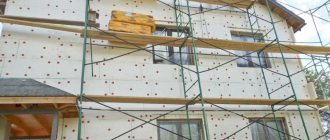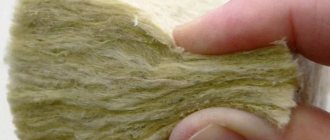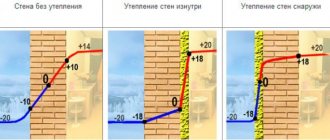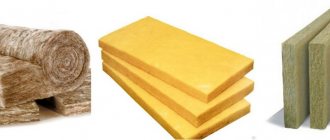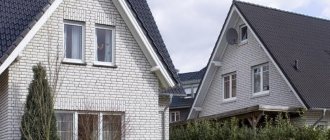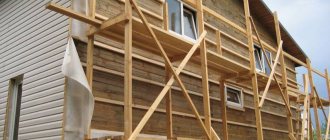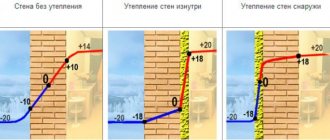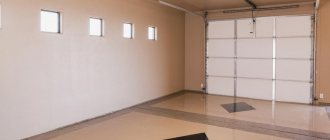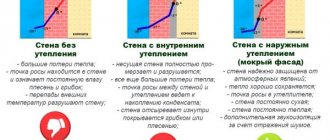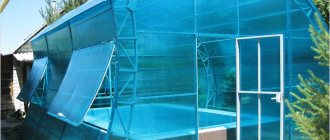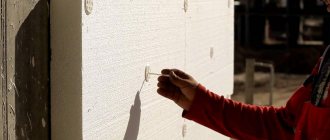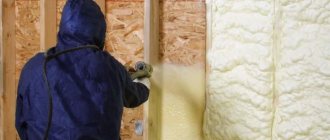Features of the heat insulator
The production of penoplex for wall insulation includes the following technological operations:
- Granules of the material are loaded into an extruder, where they are heated to 130-140°C;
- Foaming agents – porophores – are added to the portion;
- The thickened mass is squeezed out of the extruder onto a conveyor belt, after which it is cut into dimensional slabs;
The mixture of semi-finished penoplex for external wall insulation consists not only of polystyrene foam and foaming agents - it also contains antioxidants designed to prevent thermal oxidation during processing and damage to the integrity of the insulation during operation, fire retardants to increase fire resistance, as well as antistatic, light-stabilizing and modifying additives that protect thermal insulation material from the influence of external factors.
The main positive parameters of the material:
- Low moisture absorption of expanded polystyrene is the main advantage;
- The minimum coefficient of thermal conductivity, which allows, when calculating the thickness, to choose thin slabs;
- High vapor permeability of penoplex: a 20 mm thick slab replaces one layer of roofing material, but at the same time also insulates the working surface;
- High compressive strength and other mechanical loads. The extrusion method in the production of thermal insulation allows the cells of the material to be evenly distributed, improving the quality of density and strength;
- Easy and quick installation of insulation due to its low weight and good density;
- Long service life of extruded foam – up to 50 years;
- Excellent sound insulation and minimal chemical activity.
Features of penoplex
Penoplex size range:
- Slab length – from 120 to 240 cm;
- Slab width – 60 cm;
- Thickness – from 2.0 to 12.0 cm.
Disadvantages of extruded foam:
- Flammability of groups G3-G4, formation of toxic smoke during fire;
- Polymer additives in the composition of the material can evaporate toxic substances when exposed to sunlight. Therefore, the optimal use of penoplex is external, for example, insulation of brickwork;
- Petroleum products and some organic substances can deform penoplex, the thickness of which can be any. These are substances such as: formaldehyde and formalin, acetone and methyl ethyl ketone; liquids containing ethyl, benzene components, polyester resins, synthetic paints and fuels and lubricants.
Performance characteristics of penoplex
Thermal conductivity properties determine the quality of insulation with penoplex. The higher the thermal conductivity coefficient, the fewer centimeters the layer of insulating material will be. Laying the insulator from the inside or outside depends on the characteristics of vapor permeability and strength (density). You can compare the parameters of popular materials for insulating floors and other surfaces by studying the data in the table:
Comparison of thermal insulators
From the table it is clear that foam plastic thermal insulation has an average thermal conductivity value, which is slightly less than that of polyurethane foam, mastics and roll materials. But you can choose penoplex only because the layer of such liquid insulation does not have joints and seams, like slab insulation, no matter how many layers are applied to the surface.
Energy efficient house - insulation with extruded polystyrene foam. Expert recommendations
This is part of a training course on “Extruded Polystyrene Foam Insulation”. You can complete the course in full at the FORUMHOUSE Academy.
The constant increase in energy prices and the desire to build a comfortable and economical home have led to a surge of interest in the construction of energy-efficient housing. But how to make sense of the sea of insulation materials, since each of them has its own characteristics? Extruded polystyrene foam is a material that is constantly gaining momentum in the insulation market, and in this article, with the help of specialists, we will help you figure out how to make calculations when insulating with this material.
Extruded polystyrene foam (XPS) is an effective polymer thermal insulation material made by extrusion from polystyrene with the addition of a blowing gas and technological additives.
So we'll look at:
- Basic principles of energy-efficient (energy-passive) construction.
- Calculation of the required thickness of extruded polystyrene foam (XPS).
- “Breathing” walls - myth or reality.
- What engineering systems are needed for an energy-efficient house.
Energy efficiency: basic principles
When an ordinary, unprepared developer mentions the phrase “energy-efficient housing,” an image of a premium-class cottage that requires significant investment appears in his head. Hence the reluctance to invest in the construction of a well-insulated and energy-efficient house.
Practice says otherwise. If we summarize our experience, we can say that building an energy-efficient house increases the construction cost by 15-20%. Moreover, the operation of such a home, on average, costs 50-75% less than traditional construction.
Anton BorisovSpecialist of TechnoNIKOL Corporation
If you build an energy-efficient house, then savings on the funds invested in its construction begin already in the first heating season.
The heating season (depending on the climate zone) in our country, on average, lasts from 6 to 8 months. The cost of operating a home in the long term is a key factor influencing the decision to build an energy-efficient, and most importantly, economical home.
To understand the basic principles of building an energy-efficient home, you need to understand how energy is spent in the house.
The main energy consumers are electrical appliances, the hot water supply system and the heating system. Because Since a cold climate prevails in our country, the lion's share of expenses (up to 70%) in a standard house, with large heat losses, goes to heating.
An energy efficient house is a building in which all energy losses and energy consumption levels are reduced by approximately 30-70% of the consumption level in a conventional house.
Anton BorisovSpecialist of TechnoNIKOL Corporation
The main sources of heat loss in a building are the floor, walls, windows, doors, roofing and ventilation system.
The basic principle of constructing an energy efficient building is to minimize all heat loss through the building envelope. To do this, a closed and sealed thermal insulation circuit is erected and all “cold bridges” are eliminated.
A “cold bridge” is a structural part of a building (concrete lintels, joints in walls, etc.) through which, due to the low thermal resistance of this unit or material, heat loss occurs.
For clarity, the percentage of heat loss is presented in the following figure.
The energy efficiency of a house can be judged by the coefficient of seasonal thermal energy use - E.
In European countries, the EP coefficient is used to determine the energy efficiency class of a home. The starting point is EP = 1 and energy class D, i.e. standard.
The main task of additional thermal insulation of a building is to increase energy efficiency and, as a result, reduce heating costs. This results in cost savings and a lower cost of owning a home in the long run.
How to choose insulation and calculate its thickness
Having understood the basic characteristics of an energy-efficient house, you can move on to determining the optimal insulation thickness. Judging by the requests on the portal, this is one of the leading questions among our users when building a warm and comfortable home.
Ivan1985 FORUMHOUSE user
I built a house in Minsk from sand-lime brick. The wall thickness is 0.5 meters. If the temperature outside drops to -25°C, then the house cools down to 14-15°C. The house was built back in the early 90s. Judging by the masonry, the house was built with violations of technology; even the mortar was not installed everywhere. Then I completed the house and plastered it. Now I want to insulate it. I'm thinking of taking 100mm thick insulation. Builders say that 50 mm is enough. How to correctly calculate the thickness of insulation I need?
As mentioned above, heat loss through walls accounts for about 20% of all heat loss. Therefore, to insulate a house, you need high-quality and durable insulation that will not lose its properties over time. To choose him, you need to understand what qualities he should have.
Anton Borisov
Effective insulation is a heat-insulating material that, having a small thickness, increases the heat transfer resistance of enclosing structures (denoted R), i.e. prevents the transfer of heat from a room with a higher temperature (from the room) to an external environment with a lower temperature (outside).
The coefficient (R) is measured by the temperature difference in degrees Celsius (or Kelvin) required to transfer 1 W of heat through 1 sq.m. area if the temperature difference on both sides is 1°C. The unit of measurement R is (m²*°С)/W.
Starting from this definition, we move on to thermal conductivity, because This is the main characteristic of insulation. The coefficient of thermal conductivity is expressed in the ability of a material to conduct heat from a more heated part to a less heated part. Let's look at this parameter in more detail.
Any material passes thermal energy through itself. A good example is wood and steel. If you heat these two materials, steel, due to its high thermal conductivity, will heat up quickly, while wood, due to its lower coefficient, will remain warm. To illustrate this process, imagine a frying pan with a wooden handle placed on a gas stove.
Let's move on. The thermal conductivity coefficient is denoted as λ. Each building material has its own thermal conductivity coefficient. This coefficient determines the amount of thermal energy passing through 1 square meter in 1 second. m of material area with a temperature difference of 1°C. λ is measured - W/(m*°С).
Anton Borisov
The lower the thermal conductivity coefficient - (λ), the lower the heat transfer, i.e. higher thermal resistance of the structure - (R). This directly affects the thermal insulation qualities of the building envelope.
Knowing the standards for thermal resistance (R) for different regions of Russia (depending on the climatic zone) and the thermal conductivity coefficient of the material (λ) used in the construction of walls, you can calculate the required thickness of the insulation.
Table. Standardized thermal resistance of walls.
Note: for floors and coatings, the normalized thermal resistance has different values. According to the standards SP 50.13330 “Thermal protection of buildings”, the calculation must be done for a temperature of + 20 °C. (In winter, the temperature in residential premises should be maintained at 18...22 °C).
An example of calculating the insulation of a house using extruded polystyrene foam (XPS)
Due to its characteristics - low thermal conductivity coefficient (0.028-0.034 W/(m*°C), high compressive strength (200-1000 kPa) and minimal water absorption coefficient (0.2-0.4%) - this material is used for insulating the following structures:
- Floor and ceilings.
- Foundations and ground floors.
- Roofs.
Anton Borisov
Knowing what materials are used in the construction of the wall, you can calculate its thermal resistance and compliance with standards.
For example, let’s take a wall made of solid brick 0.3 meters thick. According to the standards, the thermal resistance for walls in the Moscow region should be: R - 3.065 (m²*°C)/W. From here, using the formula, we find the actual heat transfer resistance of the brickwork.
R= d/λ, where:
d—material thickness;
λ is the thermal conductivity coefficient of the material.
Rф = 0.3/0.81= 0.37 (m²*°С)/W
Based on this value, we determine the difference between the standard and actual heat transfer resistance (Rt):
Rt = Rn – Rph = 3.065 – 0.37 = 2.69 (m²*°C)/W
Now we find the thickness of the insulation we need, which compensates for this difference. The calculated thermal conductivity coefficient of extruded polystyrene foam (XPS) is 0.03 W/(m*°C). We put it in the following formula:
d = Rt * λ, where:
d—thickness of insulation;
Rt—heat transfer resistance;
λ is the thermal conductivity coefficient of the insulation.
d = Rt * λ = 2.69 * 0.03 = 0.08 m
Convert to cm, round up (taking into account the multiplicity of the thickness of the produced thermal insulation of 10 mm) and get – 8 cm.
Conclusion: to bring the thermal resistance value of a brick wall to the standardized value, it is necessary to install a layer of extruded polystyrene foam (XPS) 80 mm thick on the outside of the wall.
During the long-term operation of the building, it should be taken into account that XPS does not accumulate moisture, which means it does not lose its thermal insulation characteristics.
Anton Borisov
Using this simplified algorithm, you can independently calculate the required insulation thickness. If the wall structure consists of several layers, for example - plaster - aerated concrete - thermal insulation - facing brick, etc., then to calculate and obtain the total value of the wall's thermal resistance (R), you need to add up the indicators of each layer.
Thus, a thin layer of insulation makes it possible to achieve the required standard for the thermal resistance of enclosing structures (R). And when insulating from the inside, through the use of effective insulation, we can reduce the overall thickness of the wall structure being built up, without “eating up” the internal usable area of the house.
Engineering systems for an energy efficient home
The main principle of building an energy-efficient house is the construction of a sealed (closed), airtight shell inside the building. Those. - construction of a kind of thermos house in which all the heat is retained and is not released outside due to heat transfer, which is possible during the migration of air masses in the so-called “breathing walls.” Thus, anticipating the question from developers, we can immediately say that the so-called. “breathing of walls”, i.e. air exchange between the indoor and outdoor environments, which supposedly provides a healthy microclimate in the house - a myth! Load-bearing structures should not “breathe” and allow air to pass through; they should retain our heat inside. Appropriate systems must be responsible for “breathing the house” (removal of exhaust air and supply of fresh air).
Vinyl wallpaper, a layer of plaster, laminate, clinker brick and other finishing materials, even simple oil paint - in themselves are good layers that ensure the tightness of the system. Ventilation must maintain the microclimate in the house and ensure the flow of fresh air, which, unfortunately, is forgotten in projects. After all, a person’s well-being and the level of comfort in the home depend on the air quality and air exchange rate. In a cottage with properly installed ventilation, it is easy to breathe.
Anton Borisov
Modern standards regulate: the entire volume of air in a living space must be completely renewed once every 60 minutes.
Here lies the pitfall. Heat loss through an inefficient ventilation system can be over 30%. Those. — providing the influx of the volume of air we need in winter, we “throw out” heat outside and spend additional energy on heating the newly received air.
How to proceed? In order not to reduce the volume of incoming air, we are installing a system that will heat the cold street air using exhaust air removed from the premises. This system is called a recuperator, and it is one of the possible options for installing a ventilation system in an energy-efficient house.
A recuperator is a device where, due to heat exchange, heat is transferred from the outgoing heated air to the cold incoming flow. Due to this, heat loss is reduced and heating costs are reduced.
This is part of a training course on “Extruded Polystyrene Foam Insulation”. You can complete the course in full at the FORUMHOUSE Academy.
Calculations
To achieve high-quality and effective heat retention and complete protection from the cold, you need to know how to calculate the thickness of the insulation. Such calculation of insulation thickness is carried out using existing formulas, which take into account:
- thermal conductivity;
- heat transfer resistance of the load-bearing wall;
- coefficient of thermal conductivity;
- coefficient of thermal homogeneity.
The listed characteristics are no less important at the moment when the foam thickness is calculated.
When determining the dimensions of the selected slab made from a particular material, it is worth considering that the thickness of each product allows the use of laying in 2 layers. After calculating the thermal insulation, you can be convinced that it is most convenient and profitable to use mineral wool slabs as insulation, and the thickness of such insulation should be from 10 to 14 cm.
Calculations are carried out using a specially created formula, and to obtain accurate data characterizing the heat insulator used, you need to take into account:
thermal conductivity coefficient of the load-bearing wall; if the wall is multi-layered, then it is important to take into account the thickness of its individual layer; thermal homogeneity coefficient; we are talking about the differences between brickwork and plaster; It is important to know the thickness of the load-bearing wall.
By multiplying the sum of all indicators by the thermal conductivity coefficient of the selected insulation, you can calculate the thickness of the heat insulator.
The choice of products sold on the construction market is based on these data.
It is equally important to decide on:
- where exactly the insulation will be placed; it can be the inner surface of the walls or the facade of the building;
- what material will be used as cladding; the façade of the building can be finished with facing bricks or decorative slabs;
- how many layers of thermal insulation will be used in the construction of the structure.
When choosing the thickness of the insulation, it is important to take into account the characteristics of the region in which the building is located. In the coldest regions, you will need material whose thickness reaches 14 cm, and in warm regions it is enough to install slabs 8-10 cm thick
The video shows the procedure for determining the thickness of the insulation:
Based on the results of the calculations, you can easily select the most suitable thermal insulation material, retain heat in the house and protect the walls of the building from destruction under the influence of negative, low temperatures.
Until the second half of the 20th century, few people were interested in environmental problems; only the energy crisis that broke out in the West in the 70s raised the question: how to save heat in the house without heating the street and without overpaying for energy.
There is a solution: insulating the walls, but how to determine what thickness of insulation for the walls should be so that the structure meets modern requirements for heat transfer resistance?
The effectiveness of insulation depends on the characteristics of the insulation and the method of insulation. There are several different methods that have their own advantages:
- Monolithic structure, can be made of wood or aerated concrete.
- A multilayer structure in which the insulation occupies an intermediate position between the outer and inner parts of the wall; in this case, at the construction stage, ring masonry is performed with simultaneous insulation.
- External insulation using a wet (plaster system) or dry (ventilated facade) method.
- Internal insulation, which is performed when it is impossible to insulate the wall from the outside for some reason.
To insulate already constructed and operating buildings, external insulation is used as the most effective way to reduce heat loss.
How to insulate aerated concrete, mineral wool or polystyrene foam
Mineral (stone) wool and polystyrene foam are the main insulation materials for aerated concrete houses. Low-density aerated concrete (D200) and sprayed polyurethane foam are used much less frequently.
Insulation should be carried out only from the outside of the building so that the dew point is closer to the outer layer of the wall.
Dew point is a place in the wall with zero temperature. In this zone, a zone of increased condensation (moisture) is formed; the wall in this place constantly freezes and thaws.
If we compare polystyrene foam and mineral wool, then wool is a more expensive and correct solution for aerated concrete walls; it’s all about vapor permeability. Cotton wool has excellent vapor permeability, which ensures that moisture is removed from the wall to the outside of the house. Thus, the interior will be drier and more comfortable. The thickness of mineral wool insulation can be made to any thickness, but it is more economically feasible - from 100 mm.
Polystyrene foam does not allow steam to pass through well, trapping it in the wall and creating increased humidity in the house. Moreover, aerated concrete walls need to be insulated with foam plastic with a thickness of 100 mm or more in order to guarantee that the dew point will shift from the wall to the insulation. Otherwise, at the boundary between the foam plastic and the wall, moisture will constantly freeze and thaw, reducing the service life of the wall.
In general, we recommend using mineral wool or foam plastic with a thickness of 100 mm or more, but it is better to give preference to mineral wool.
Why is it important to choose the right foam thickness?
The choice of foam thickness makes it possible to ensure the required level of surface thermal insulation and sufficient strength properties of the heat-insulating layer. The thicker the material, the stronger it is and it is much easier to work with during installation. On the other hand, thick sheets have significant weight, which can be critical, for example, when insulating a ceiling.
If the thickness was not chosen correctly, then there is a high probability that it may be less than the minimum required, and in such cases the following consequences may arise:
- the house structures will freeze, as a result of which they will lose their strength characteristics and their service life will be reduced;
- the dew point in the load-bearing walls will shift and condensation will form inside the material, which is fraught with the appearance of mold, mildew and harmful microorganisms;
- a reliable basis for applying the finishing coating will not be provided;
- heating equipment will not be able to provide a comfortable indoor temperature or will operate with high fuel or electricity consumption.
If you use polystyrene with excess thickness for insulation, this will be a waste of funds.
TOP 3 best products according to customers
Foam plastic 1000x1000x100 mm (density 25)
270.00 rub.
Product code 2954
Foam plastic Mosstroy-31 1000x1000x100 mm (density 25) - heat-insulating, moisture-resistant boards.....
Foam plastic 1000x1000x50 mm (density 25)
135.00 rub.
Product code 2975
Foam plastic Mosstroy-31 1000x1000x50 mm (density 25) - heat-insulating, moisture-resistant boards for.....
Foam plastic 1000x2000x50 mm (density 25 F)
300.00 rub.
Product code 3008
Foam plastic Mosstroy-31 1000x2000x50 mm (density 25 F) - heat-insulating, moisture-resistant boards.....
Thermal insulation method
The effectiveness of insulation depends on the characteristics of the insulation and the method of insulation. There are several different methods that have their own advantages:
- Monolithic structure, can be made of wood or aerated concrete.
- A multilayer structure in which the insulation occupies an intermediate position between the outer and inner parts of the wall; in this case, at the construction stage, ring masonry is performed with simultaneous insulation.
- External insulation using a wet (plaster system) or dry (ventilated facade) method.
- Internal insulation, which is performed when it is impossible to insulate the wall from the outside for some reason.
To insulate already constructed and operating buildings, external insulation is used as the most effective way to reduce heat loss.
Is it possible to use polystyrene foam on concrete walls?
Another important characteristic of any insulation is vapor permeability.
Polystyrene almost does not allow vapor to pass from the room to the street, but for insulating concrete walls this does not matter, since the materials are similar in performance. If the premises of a brick or expanded clay concrete house are humid, properly arranged ventilation solves the problem.
It is not advisable to insulate concrete walls from the inside for permanent housing. In cold weather, the dew point (freezing point) will move closer to the inside, the walls will freeze to their entire thickness.
Internal insulation is beneficial for dachas that are not constantly heated. In this case, the building will warm up faster, since the house will become warm before the brick (stone, expanded clay concrete) walls warm up - the heat from the heating devices, like in a thermos, will be retained by the foam plastic.
Standard length, width and thickness of bricks
Since bricks have their own standard dimensions (6.5 x 12 x 25), the thickness of the brick wall will have several standard dimensions, taking into account the thickness of the seam between adjacent bricks.
There are other sizes, but they mainly differ in height, and the height of the brick does not affect the thickness of the wall.
Standard dimensions of a brick wall
| Number of bricks, pcs | Wall thickness, cm |
| 0,5 | 12 |
| 1 | 25 |
| 1,5 | 38 |
| 2 | 51 |
| 2,5 | 64 |
In addition to the thickness of 65 mm, there are brick thicknesses of 88 mm - one-and-a-half bricks and 138 mm - double bricks. Those. sizes 8.8x12x25 and 13.8x12x25. In general, the thickness (height) of the brick does not in any way affect the thickness of the brickwork.
The main criterion when choosing the thickness of a brick wall is the purpose and location of the wall itself.
Slab size
Foam boards are produced mainly in three sizes: 0.5 * 1, 1 * 1 and 2 * 1 m. It is immediately worth noting that this insulation is easy to cut, so no problems should arise during the installation process. So, it is better to choose the material that is most suitable for the area of the insulated surface. As a rule, for insulating balconies, loggias and apartments in apartment buildings, the choice is made on slabs measuring 0.5 * 1 m : they are most convenient to work with, they are more economical, and it will be easier to insulate all kinds of complex facade details with such material. But if you need to insulate a private house, the walls of which have a regular flat surface, then it makes sense to use slabs measuring 1 * 1 m. The largest material, slabs measuring 2 * 1 m are used least often for particularly large buildings.
Calculate the thickness of the insulation
Thermal insulation of the outer wall reduces heat loss by two or more times. For a country, most of whose territory belongs to a continental and sharply continental climate with a long period of low negative temperatures, like Russia, thermal insulation of enclosing structures provides a huge economic effect.
Whether the thickness of the heat insulator for external walls is correctly calculated determines the durability of the structure and the microclimate in the room: if the thickness of the heat insulator is insufficient, the dew point is located inside the wall material or on its inner surface, which causes the formation of condensation, high humidity, and then the formation of mold and fungal infection.
The method for calculating the thickness of insulation is prescribed in the Code of Rules “SP 50. 13330. 2012 SNiP 23–02–2003. Thermal protection of buildings."
Factors influencing the calculation:
- Characteristics of the wall material - thickness, design, thermal conductivity, density.
- Climatic characteristics of the building area - the air temperature of the coldest five-day period.
- Characteristics of materials of additional layers (cladding or plaster of the inner surface of the wall).
The insulation layer that meets regulatory requirements is calculated using the formula:
In the “ventilated facade” insulation system, the thermal resistance of the curtain wall material and the ventilated gap is not taken into account in the calculation.
Example of calculating wall thickness
The thickness of the insulation of a frame house for permanent residence using the example of the Moscow region (this calculation was given above) was 150 mm when using mineral wool with a density of 50 kg/m3. Since most manufacturers produce this insulation in thicknesses of 50 and 100 mm, you will have to put insulation in either three layers of 50 mm thickness, or two layers of 100 and 50 mm. This will not change the thermal conductivity coefficient.
OSB with a thickness of 12 mm with an air gap of 50 mm and plaster of 5 mm was chosen as the external cladding.
The interior is lined with 13 mm plasterboard.
Total: 150 + 12 + 50 + 5 + 13 = 230 (mm).
Now, based on these data, you can now calculate the foundation, but you need to understand that this is just a mathematical calculation and it does not take into account problems that may arise during installation of the structure.
To make sure that there is no draft anywhere in the house, the structure is checked with a thermal imager
What do you need to know about sizes? What are they?
Foam sheets can be standard or custom sizes.
The length and width of the standard sheet are 1000, 2000 mm. The manufacturer can cut products into other non-standard sizes.
You can often find sheets of 1200x600 that meet the needs of the buyer and are in good demand. This can be a sheet with dimensions of 500x500, 1000x1000, 1000x500 mm.
On order, you can receive a batch of expanded polystyrene with sides of 900x500 or 1200x600 and other sizes, which does not contradict the standards.
GOST allows cutting products 10 mm smaller if its length is over 2000 and its width is 1000 mm. In thickness for slabs up to 50 mm, a difference of ±2 mm is allowed, and over 50, a difference of ±3 is allowed.
If the length is not suitable for the buyer, then companies selling such products offer individual cutting.
Length and width are important only for transporting building materials from the manufacturer to the customer. The main role is given to the thickness of the material.
The length of extruded polystyrene foam (EPS) sheets is 1200-2400 mm, width - 500-600 mm, and thickness 20-150.
To select a specific value, it is recommended to start from the scope of application, for example, for thickness, the following tips:
- for the floor on the first floor - from 50 mm;
- for the second floor and above – 20-30 mm;
- for additional sound insulation on the floor - 40 mm;
- for internal wall cladding – 20-30 mm;
- for external wall cladding – 50-150 mm.
Penoplex thickness for insulation
Penoplex is a derivative of the extrusion of polystyrene foam, a higher quality type of foam, to which improvers are added when pressed through a mold. There are quite a few brands of penoplex, and the choice of a suitable material for insulating a house outside or inside depends not only on the properties of a particular class of penoplex - the functional purpose of the room, the thickness of the penoplex, installation parameters, and many other factors will play a role here. To navigate the properties of this insulation, you should study its characteristics.
Penoplex production
How to calculate the thickness of insulation
- The required total thermal resistance (R) is 5.28.
- R of aerated concrete wall 400 mm from D500 – 2.6.
- R of the insulation should be: 5.28-2.6 = 2.68
Now you need to use a table that shows the thermal conductivity of insulation materials, in our case mineral wool.
AGB – autoclaved aerated concrete
The thermal conductivity of mineral wool at equilibrium humidity is 0.05.
The thickness of the insulation is determined quite simply: the required thermal resistance of the insulation is multiplied by its thermal conductivity, that is
2.68 x 0.05 = 0.134 meters.
Conclusion: we need mineral wool with a thickness of 134 mm. But mineral wool slabs are sold in multiples of 50 mm, which means the insulation layer will be 150 mm.
Important! The economically justified thickness of mineral wool for wet facades is from 100 mm. Since when installing insulation (wet facade) it is necessary to use several layers of plaster, mesh, facade umbrellas, and other fasteners, there will not be much savings between insulation thicknesses of 50 and 100 mm
And the cost of work and consumables when installing insulation of different thicknesses is almost the same
Since when installing insulation (wet facade) it is necessary to use several layers of plaster, mesh, facade umbrellas, and other fasteners, there will not be much savings between insulation thicknesses of 50 and 100 mm. And the cost of work and consumables when installing insulation of different thicknesses is almost the same.
We also note that 100 mm of insulation, in 90% of cases, shifts the dew point from the wall to the insulation. That is, moisture will never freeze in the wall, therefore, the service life of such a wall will be almost endless.
Characteristics of various materials
Table 1
The value of the standardized heat transfer resistance of an external wall depends on the region of the Russian Federation in which the building is located.
table 2
The required layer of thermal insulation material is determined based on the following conditions:
- the external enclosing structure of the building is solid ceramic brick of plastic pressing with a thickness of 380 mm;
- interior finishing – plaster with cement-lime composition 20 mm thick;
- external finishing – a layer of polymer-cement plaster, layer thickness 0.8 cm;
- the coefficient of thermal homogeneity of the structure is 0.9;
- thermal conductivity coefficient of insulation - λA=0.040; λB=0.042.
What is penoplex
Heat loss through the walls of a building can range from ¼ to 1/3 of the total. Increasing thermal resistance due to the inclusion of special coatings in the design of external walls makes it possible to reduce its thickness and reduce the consumption of other building materials.
Wall insulation is necessary not only to prevent heat from escaping from the house in the cold season, but also to excessive heating of the room in the summer, so the correct choice of a heat insulator determines the financial costs not only during construction, but also during operation (heating, air conditioning).
Differences from other options
In the name of this insulation, you should pay attention to the word “extruded”, since a different production technology distinguishes it from ordinary polystyrene. The molten polymer is passed under high pressure through small nozzles, resulting in a dense foam board with a thickness of 20 to 100 mm as a result of solidification.
The molten polymer is passed under high pressure through small nozzles, resulting in a dense foam board with a thickness of 20 to 100 mm as a result of solidification.
The technical characteristics of various brands of penoplex are presented in the summary table:
Of the presented types, only 45 are used for making road surfaces, the rest are used for insulating residential buildings.
Meaning of indicators
The fine-porous structure of penoplex (100 - 200 microns) makes it a fairly light but durable material. Its characteristic qualities are:
- resistance to mechanical loads (when laid on a flat surface);
- low vapor permeability (thickness 20 mm is comparable to 1 layer of roofing felt);
- moisture resistance allows use on the outside of walls, in bathhouses, bathrooms, basement levels without heating;
- the insignificant coefficient of thermal conductivity expands the possibilities of use in thin partitions created with your own hands: balcony railings, veranda walls, extensions or garages;
- low weight does not lead to a significant increase in the load on the base when covering already designed structures (insulation of individual apartments in a multi-storey building);
- the density of the polymer allows the use of conventional cutting tools to adjust sheets to size when performing work;
- chemical resistance to most compounds used in construction (exceptions: gasoline, diesel fuel, acetone, enamels, oil paints, formaldehyde, acetate-based solvents). For more information about the qualities of the material, watch this video:
What to compare with
The listed characteristics classify penoplex among modern achievements in the line of traditional insulation and polymer counterparts.
The ratio of technical characteristics can be seen in the reference tables of materials:
Do-it-yourself technology for insulating external walls with polystyrene foam
A craftsman familiar with the basics of finishing work can insulate walls.
Let us consider in detail the insulation method called “wet facade”.
Tools
For work you will need hand and power tools:
- level, plumb line, hammer, tape measure, pencil, hacksaw (knife), trowel and spatula;
- bucket for stirring glue and plaster;
- hammer drill or impact drill with bits or drills for concrete;
- whisk attachments for drills for preparing solutions.
From consumables purchase:
- glue for polystyrene on a cement or synthetic basis;
- dowels with a rod length 4-5 cm greater than the thickness of the foam;
- mounting foam or adhesive foam;
- foam gun.
Work progress step by step
Wall insulation begins with preparatory work:
- calculating the amount of insulation and its purchase;
You can calculate the area and amount of material by adding up the area of all external walls. When purchasing, add 5% to the calculations for possible errors during fitting and purchase 6-7 special dowels for each square meter at the joints of sheets at the outer corners of the walls.
- preparing and checking instruments;
- purchases of consumables;
- installation of scaffolding (if necessary).
The work is carried out in the following sequence:
- The surface of the walls is prepared and cleaned of dust and dirt.
- The voids in the seams (if any) are sealed with cement mortar or foam.
- Level the surface with plaster so that unevenness does not exceed 1.5 - 2 cm. This will make it easier to fit the sheets and reduce the amount of expensive glue during further finishing.
- At a level of 50 cm from the ground, a support bar is attached strictly horizontally, if the foam is not placed to the ground, but finishing is provided with another material.
- Using a level and plumb line, markings are made.
- Apply a sheet according to the markings and through it (to avoid mistakes) drill a hole in the wall for the dowel.
- Starting from the central hole, fix the sheet to the wall.
You can attach foam to a flat surface using only dowels. For fastening to poorly plastered walls, a layer of glue is applied to the material plates and pressed against the wall. For reliability, you can fasten the dowels after a day.
When installing the first row, the level is precisely maintained. This will help avoid gaps when installing subsequent slabs.
- The second and subsequent sheets are placed offset (in a checkerboard pattern).
- The seams are sealed with polyurethane foam. Remove excess sealant after complete hardening, usually after 12 hours and up to 24 hours.
Instead of polyurethane foam, it is better to use adhesive foam - it has a lower coefficient of secondary expansion and adheres sheets better.
- Using a special toothed roller or other available means, punctures up to 0.5 - 1 cm deep are made on the surface of the foam for better adhesion to the layer of adhesive plaster.
- A 1-2 mm layer of specialized polystyrene foam adhesive is applied to the foam plastic, which is leveled with a spatula.
- A fiberglass mesh is applied to the glue and “sunk in.” The joints are overlapped, overlapping by 10 cm. The seams between the sheets and the edges of the mesh should not coincide.
- Level the glue with a spatula. By adding portions of glue in the right places, the final leveling of the surface is carried out, working as if using putty.
Finishing
After the composition has dried, prime the surface with products for external use.
The final finishing is carried out with facade paint or bark beetle plaster. The latter option is preferable, as it hides inaccuracies and irregularities, which are especially visible in side lighting.
There are no tricks when it comes to frame insulation. The foam is secured with wide-headed dowels between the frame slats. The remaining voids are filled with polyurethane foam or adhesive foam. Then, without fail, a waterproofing membrane is nailed to the frame. It is convenient to do this with counter-lattice bars, the thickness of which is 1-1.5 cm. After installing the siding or other material, there will be a gap between it and the foam, which will reduce the likelihood of dampening of the materials - the facade will become “ventilated”.
Variety and features of insulation
Modern manufacturers offer a wide range of materials used as insulation and meeting all existing requirements and standards:
- Styrofoam;
- basalt or stone mineral wool;
- penoplex;
Before making your final choice, you need to familiarize yourself in detail with the features and advantages of each of them. Having studied the technical characteristics of various materials, we can safely say that the leaders in their main qualities are slabs of mineral wool or basalt insulation, as well as slabs for wall insulation.
The basis for the choice is data on the thermal conductivity, thickness and density of each material:
- stone wool - from 130 to 145 kg/m³;
- expanded polystyrene - from 15 to 25 kg/m³;
- penoplex - from 25 to 35 kg/m³.
The density of basalt wool reaches 100 kg/m³, which makes basalt insulation one of the most popular and popular. This does not mean that consumers should abandon the use of mineral wool as an insulating material used during finishing work before facing the façade walls of a building made of brick.
Thermal insulation material is selected based on the most significant characteristics of each. Having decided to choose polystyrene foam as a reliable and effective heat insulator, it is necessary to clarify the dimensions of the slab, its density, weight, vapor permeability, and resistance to moisture. Despite many positive qualities, this wall insulation also has some negative features:
- susceptible to destruction by rodents;
- high degree of flammability.
This forces consumers to select other materials, among which mineral wool is the most popular for wall insulation. It is characterized by high density, low weight, and low thermal conductivity. Its vapor permeability allows you to ensure a normal level of humidity. In addition, mineral wool is one of the fire-resistant materials.
Extruded polystyrene foam is in demand among consumers. These plates are characterized by a high degree of resistance to mechanical damage. EPS is not susceptible to rotting, the formation of fungus and mold, and is resistant to moisture. It is used to insulate the basement and load-bearing walls. In the latter case, slabs are installed whose density is 35 kg/m³.
Advantages and disadvantages
Foamed polystyrene is a synthetic material whose positive properties make it an excellent insulation material. Advantages compared to other materials:
- Low specific gravity. One cubic meter of foamed polystyrene weighs from 11 to 40 kg. This amount of material with a sheet thickness of 50 mm is enough to insulate 20 square meters. m. walls.
- Insignificant price compared to other insulation materials.
- Low thermal conductivity, contributing to energy saving during the heating season and keeping cool in the summer.
- High levels of noise insulation, providing comfortable conditions in houses located along busy streets.
- Strength sufficient for mounting plates in a variety of ways.
- Easy installation.
- Available at any hardware store.
Among the shortcomings are noted:
- low vapor permeability;
- toxicity when heated;
- the need for external finishing to protect from direct exposure to sunlight (foam is destroyed by ultraviolet radiation).
Frame house projects
- 1 room
- 1 bathroom
- 42² Total area
- 6 x 7m Construction area
- 1 room
- 1 bathroom
- 28² Total area
- 5 x 4m Building area
- 4 rooms
- 2 bathrooms
- 170² Total area
- 11 x 8m Construction area
- 3 rooms
- 2 bathrooms
- 127² Total area
- 10 x 7m Construction area
- 4 rooms
- 2 bathrooms
- 200² Total area
- 9 x 13m Construction area
- 4 rooms
- 2 bathrooms
- 140² Total area
- 12 x 9m Construction area
- 3 rooms
- 2 bathrooms
- 127² Total area
- 9 x 8m Construction area
- 4 rooms
- 2 bathrooms
- 130² Total area
- 10 x 10m Construction area
- 3 rooms
- 1 bathroom
- 83² Total area
- 10 x 9m Construction area
- 1 room
- 1 bathroom
- 30² Total area
- 7 x 6m Building area
- 3 rooms
- 2 bathrooms
- 156² Total area
- 11 x 9m Construction area
- 4 rooms
- 2 bathrooms
- 140² Total area
- 8 x 9m Construction area
- 4 rooms
- 2 bathrooms
- 120² Total area
- 8 x 10m Construction area
- 1 room
- 1 bathroom
- 35² Total area
- 5 x 9m Construction area
- 2 rooms
- 1 bathroom
- 42² Total area
- 6 x 9m Construction area
- 2 rooms
- 1 bathroom
- 72² Total area
- 12 x 6m Construction area
- 2 rooms
- 1 bathroom
- 74² Total area
- 7 x 6m Building area
- 3 rooms
- 1 bathroom
- 110² Total area
- 13 x 9m Construction area
- 3 rooms
- 1 bathroom
- 75² Total area
- 9 x 7m Construction area
- 1 room
- 1 bathroom
- 45² Total area
- 6 x 9m Construction area
At a fairly low price, the quality of materials used in frame housing construction is growing every year. It is not surprising that this type of building is becoming increasingly widespread in all regions of Russia. And depending on the climate zone, the same project will have different requirements for heat conservation, therefore, what the thickness of the walls of a frame house should be must be determined in each case separately.
There are several subtypes of frame technology - if the general principle of building houses is the same, then the nuances, including the thickness of the walls, may differ
What materials are used for insulation?
Mineral wool is one of the most common insulation materials, which is characterized by good thermal insulation, but has a significant drawback: high moisture absorption. In this case, it is recommended to protect the wool with hydro- and vapor barrier.
Fiberglass is a good heat insulator. The material is resistant to high temperatures and does not rot. Mineral wool can be used not only for insulating the external walls of a brick house, but also for thermal insulation of a chimney in a boiler room or bathhouse.
Cellulose wool is used mostly for interior work. The material has good characteristics, with the exception of a high degree of moisture absorption and low resistance to mechanical loads. Note that this heat insulator is environmentally friendly.
A good option for insulating brick walls from the outside or inside is polyurethane foam, which is characterized by resistance to mold and is not susceptible to rotting. The material can be used without any problems when insulating a brick house with your own hands.
Insulation such as expanded polystyrene (foam plastic), which is characterized by low cost and high thermal insulation, is also widely used. It is necessary to take into account that the material does not absorb moisture, but is also highly flammable. It is not recommended to use it in residential buildings; however, internal insulation of brick walls is often carried out using polystyrene foam.
Extruded polystyrene foam has similar characteristics. Among the positive features, it is worth highlighting the low vapor permeability and high strength index. The characteristics of the material are maintained even at high humidity levels. It can be used not only for insulating a brick house from the inside or outside, but also in the construction of an insulated blind area, since this design has a longer service life.
Expanded polystyrene insulation in country and cottage-type houses
Many developers use the material for external insulation of facades and ceiling structures of country houses, which are being converted for year-round living. The main range of applications for polystyrene foam insulation is finishing foundations, blind areas, and insulating cement screeds under floor tiles.
Unlike mineral wool, expanded polystyrene does not require film or mastic waterproofing, so it can be mounted directly on a flat ground surface.
Why is it necessary to calculate the thickness of insulation?
Comfortable living in the house involves maintaining optimal indoor temperature, especially in winter. When constructing a building, you should remember about thermal insulation; you should correctly select and calculate the thickness of insulation for the walls, roof, floor and attic. Any material - brick, wood, foam block or mineral wool - has its own value of thermal conductivity and thermal resistance.
A warm home is every owner’s dream
Thermal conductivity is the ability of a material to conduct heat. This value is determined in laboratory conditions, and the obtained data is provided by the manufacturer on the packaging or. Thermal resistance of a material is the reciprocal value of thermal conductivity. A material that conducts heat well has low heat resistance and requires insulation.
When constructing a building, you should remember about high-quality thermal insulation. If mistakes were made in the walls of the house or in other structures during construction, then cold bridges may appear - areas through which heat quickly escapes from the house. In these places, condensation may appear, and subsequently the formation of mold, if insulation measures are not taken during the process.
